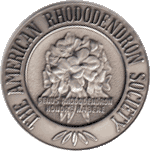
Companion Trees for
Rhododendrons & Azaleas
Since rhododendrons have shallow roots and love partial shade, it is a common problem to find a suitable shade tree. Four trees are well known for having deep roots, being fast growing, and providing the "high shade" that is often recommended for rhododendrons and azaleas. These are Ginkgo biloba or the "Maidenhair tree", Metasequoia glyptostroboides commonly know as the "Dawn redwood", Nyssa sylvatica or the "Sour Gum", Quercus rubra or the "Northern Red Oak". Even with well-behaved trees such as these it is always good to dig down about 5 inches between adjacent rhododendrons or azaleas to prevent the intervention of other roots into their root space. It is not uncommon to find tree roots growing well beyond the drip line of a tree, so trees in the immediate vicinity are not the only concern.
 Ginkgo biloba (maidenhair tree) Ginkgo biloba (maidenhair tree)
There are no known forests of ginkgoes, even in China, where Western travelers first found them in the 17th Century growing in temple gardens. These few cultivated trees turned out to be living relics of prehistoric times, among the last survivors of one of the first groups of plants that abandoned spore propagation for the more efficient seed method. The impressions of their ancestors' leaves may be seen in various parts of the world, including the United States, in rocks that are known to be millions of years old. The tree is called maidenhair tree because the 4-inch smooth green leaves resemble those of the maidenhair fern. They are fan-shaped, tough and completely free of insects and diseases, and turn a lovely shade of yellow in fall. The Chinese have another name for the ginkgo that is derived from the shape of its leaves: they call it "the tree with leaves like a duck's foot."
The Japanese have a special affection for the ginkgo tree, a plant that is a holdover from the days when dinosaurs roamed the earth. Its survival to modern times is largely due to Buddhist monks, who saved it from extinction by planting it in their temple gardens; it no longer exists in the wild. Ginkgoes probably arrived in Japan from mainland China along with Buddhism, around 800 A.D., and have been a feature of Japanese gardens ever since. They are admired for their resilience and for the fan-shaped foliage that turns a beautiful golden color in the fall. Ginkgoes are used as specimen trees, as windbreaks and are sometimes pruned in the manner of bonsai.
The ginkgo is not the tree for every backyard. One reason is that it eventually reaches a height of up to 80 feet with a spread of 40 feet or more, but another factor of importance is that it needs nearly 20 years to get over the gawky stages of adolescence and develop the broadly spreading branches of maturity. Young trees 8 to 10 feet tall may require 10 to 12 years to reach 20 feet in height. When they are young, ginkgoes are characterized by long ascending branches that develop asymmetrically. Once recommended for urban plantings because it tolerated fumes and dust, the ginkgo has been discovered to be among the first trees damaged by air pollutants.
There is only one species of ginkgo. Its fan-shaped leaves, 2 to 3 inches across, resemble those of the maidenhair fern, hence the tree's common name. They offer little shade when the tree is young. In the spring, the ginkgo bears inconspicuous male and female flowers on separate trees. It is important to plant only male trees because in late fall the female ones bear bright yellow fruit that has an extremely obnoxious odor. (In the Orient the outer evil-smelling pulp of each fruit is removed to reveal an edible white nut-like seed that is prized as a delicacy.) Nurserymen generally sell only the male trees and have selected several excellent varieties. Among them are 'Autumn Gold', a handsome broad spreading tree, and the Sentry ginkgo, G. biloba 'Fastigiata', a narrow column-shaped type.
How To Grow Ginkgo
Ginkgoes are hardy to Zone 4. They need sun but will grow in
almost any soil. They are particularly easy to establish in the
garden. Prune the young trees early in the spring. Pruning of
older trees is hardly ever necessary. Propagate male ginkgoes
from cuttings of new wood. Seedlings do not produce their first
flowers for 20 years or more.
 Nyssa sylvatica "Sour Gum" Nyssa sylvatica "Sour Gum"
The sour gum is outstanding in early fall when its 2- to 5-inch
shiny green leaves take on warm tones of orange and red. One of
the few deciduous trees that have autumn color in mild climates,
it is also valuable in wet, swampy areas where few other trees
survive. The sour gum grows from 5 to 6 feet to about 20 feet
in 10 to 15 years, usually reaching 30 to 50 feet with a spread
equal to half its height. Young trees have a conical shape, but
older ones become irregular and flat-topped; young or old, they
have distinctive horizontal branches that dip slightly at the
tips. This is apparent throughout the year but is especially effective
in winter after the leaves have fallen. In early summer sour gums
bear tiny greenish yellow male and female flowers on separate
trees. If trees of both sexes happen to be near one another, the
flowers on the female trees are followed in early fall by clusters
of 1/2-inch blue-black fruit, which are not very tasty to humans
but are eagerly eaten by birds. The sour gum has notably pest-free
foliage and even succeeds in seaside gardens if protected from
wind.
How To Grow Sour Gum
The sour gum is hardy to Zone 3. It does best in full sun and
moist acid soil (pH 5.5 to 6.5) but tolerates light shade and
ordinary garden soil provided it is watered deeply during dry
weather. The sour gum is notoriously difficult to establish in
the garden and must be planted balled and burlapped--that is, with
its roots in its original soil ball wrapped in burlap--preferably
in early spring. Pruning is seldom required but should be done
in fall.
 Metasequoia glyptostroboides (dawn redwood) Metasequoia glyptostroboides (dawn redwood)
Until 1945 the dawn redwood was known only in the form of fossils
collected by paleobotanists and was thought to have been extinct
for perhaps a million years. After it was discovered alive and
well in the remote village of Motao-chi in the Chinese province
of Szechwan, the Arnold Arboretum of Boston sent a special expedition
to the area. The seeds collected were shared with other botanical
gardens around the world, and this deciduous conifer is now widely
available from nurserymen. Mature trees in China are broadly conical
and grow about 100 feet tall from thick-buttressed roots. Presumably
they will eventually attain a similar size in this country--young
plants grow 3 feet or more a year--making them too tall for the
average garden. On a large lawn, however, they can attract attention
not only for their history but also for their foliage. Soft, bright
green needles, about 3/4 inch long, appear in early spring, then
turn pinkish brown before falling in the autumn. Brown cones 3/4
inch long ripen each year.
How To Grow Dawn Redwood
Dawn redwood is hardy to Zone 5. It thrives in full sun in
almost any moist soil. Because it tends to continue growing until
late in the summer, it should be planted in a location not subject
to early frosts-- thus plant on a hillside rather than in a valley.
Growth is symmetrical and pruning is not necessary.
 Quercus rubra "Red Oak" Quercus rubra "Red Oak"
Most oaks grow more than 50 feet tall and often as wide and make fine street or shade trees on larger lots. They are hardy, dependable trees that grow well in most soils, with branches strong enough to resist damage from wind, ice or snow. Many have large, handsome, deeply lobed leaves and are noted for their brilliant fall color.
Oak trees are deciduous and broad-leaved evergreens that grow 35 to 100 feet tall. They are distributed across the North American continent in both cold and tropical regions. Some grow fast, others slow, and leaves vary immensely in size and form, not necessarily conforming to the so-called oak leaf pattern. However, most oak trees share a common shape: rounded and broadly spreading. All have tough branches that are resistant to damage from wind or ice, and their life span is measured in centuries.
The red oak, Q. rubra, grows rapidly: an 8- to 10-foot tree reaches a height of 20 feet in five or six years and eventually becomes 60 to 75 feet tall with a spread of 40 to 50 feet. Its 5- to 9-inch leaves turn red in autumn. The red oak is an excellent large shade tree that can withstand pollution. A superior shade tree, the northern red oak transplants easily, grows faster than most oaks, to 60 to 75 feet, and tolerates city conditions.
How To Grow Red Oak
Nearly all oaks need full sun and moist, acid, well-drained,
rich deep soil. Prune young trees in winter or early spring; old
trees seldom need pruning. Oak trees grow in Zones 2-10.
Directory of Contents for Henning's Rhododendron & Azalea Pages
•• Providing Information about the Genus Rhododendron since 1996
••
Articles Published by the American Rhododendron Society
Return to Top

Last Updated:
July 6, 2020
|








